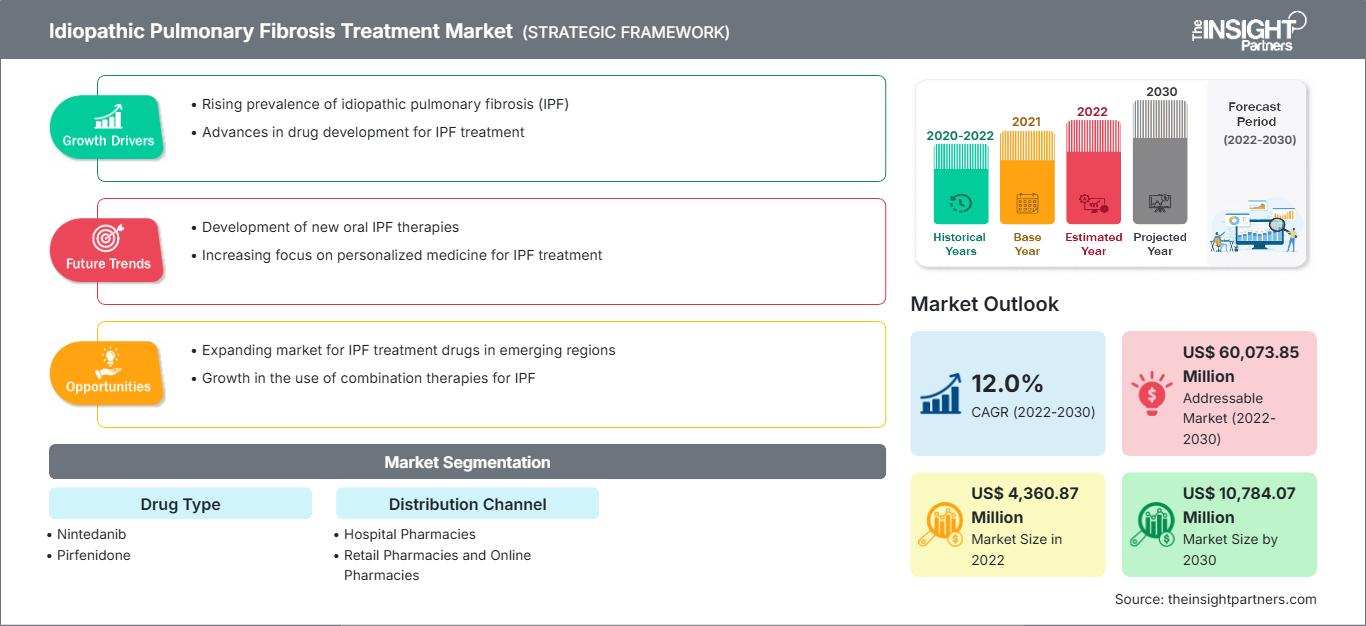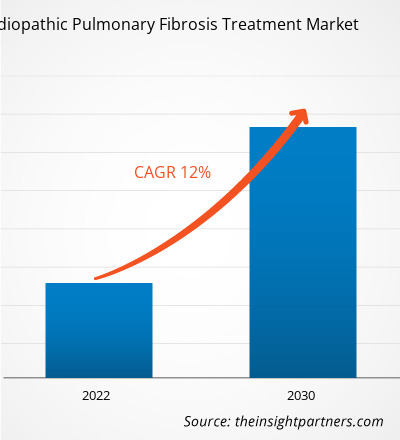[연구 보고서] 특발성 폐섬유증 치료 시장 규모는 2022년 43억 6,087만 달러에서 2030년 107억 8,407만 달러로 급증할 것으로 예상되며, 2022년부터 2030년까지 연평균 성장률 12.0%로 성장할 것으로 예상됩니다.
분석가 관점:
특발성 폐섬유증은 폐의 폐포 주변 조직에 영향을 미치는 만성 질환입니다. 폐 조직이 알 수 없는 이유로 뻣뻣해지고 두꺼워지면서 발생하며, 이러한 변화는 시간이 지남에 따라 폐에 영구적인 흉터를 형성하여 환자의 호흡 곤란을 유발합니다. 현재 특발성 폐섬유증에 대한 정확한 치료법은 없습니다. 폐 재활, 약물 치료, 수술적 시술과 같은 치료법은 폐 손상을 늦추고 환자의 삶의 질을 향상시키는 데 도움이 됩니다.
특발성 폐섬유증의 유병률 증가와 흡연 인구 증가는 향후 효과적인 치료제에 대한 수요를 촉진하고 있습니다. 특발성 폐섬유증 치료에 효과적인 약물을 도입하기 위한 지속적인 연구 활동은 향후 시장에 더욱 긍정적인 영향을 미칠 것으로 예상됩니다. 현재 선진국과 신흥국 모두에서 의료비 지출이 증가하고 있으며, 이는 이 시장의 제조업체들이 새롭고 혁신적인 제품 개발에 집중하는 노력을 강화하도록 장려할 것으로 예상됩니다.
시장 개요:
섬유증은 정상적인 치유 과정의 일부로 발생하는 결합 조직의 침착 또는 병리학적 과정으로 발생하는 과도한 조직의 침착입니다. 특발성 폐섬유증은 폐의 결합 조직과 폐포(폐의 기낭)에 영향을 미칩니다. 이 질환은 일상생활을 하는 동안 호흡곤란을 유발할 수 있지만, 건강한 사람들에게는 그다지 힘든 일이 아닙니다. 특발성 폐섬유증 치료 시장의 성장은 섬유증 질환의 증가와 흡연 인구의 급증에 기인합니다. 급속한 연구 개발 활동은 치료법의 기술 발전을 이끌고 있으며, 이는 향후 몇 년 동안 특발성 폐섬유증 치료 시장의 성장 기회를 제공할 것으로 예상됩니다.
요구 사항에 맞게 이 보고서를 사용자 정의하십시오.
이 보고서의 일부, 국가 수준 분석, Excel 데이터 팩을 포함하여 모든 보고서에 대한 사용자 정의를 무료로 받을 수 있을 뿐만 아니라 스타트업 및 대학을 위한 훌륭한 제안 및 할인을 이용할 수 있습니다
특발성 폐섬유증 치료 시장: 전략적 통찰력

-
이 보고서의 주요 주요 시장 동향을 확인하세요.이 무료 샘플에는 시장 동향부터 추정 및 예측에 이르기까지 데이터 분석이 포함됩니다.
시장 성장 동력:
특발성 폐섬유증 부담 증가로 특발성 폐섬유증 치료 시장 성장 견인
미국폐협회(ALA)의 2022년 11월 업데이트 데이터에 따르면, 미국에서는 매년 약 5만 건의 특발성 폐섬유증 신규 환자가 진단됩니다. 이러한 질환의 증상은 50~70세 환자에서 더욱 두드러집니다. 2022년 9월 British Medical Journal에 발표된 논문에 따르면, 2021년 전문치료실에서 특발성 폐섬유증 유병률은 인구 10만 명당 36.0명으로 추산됩니다. 특발성 폐섬유증 환자 수는 노화, 비만, 고혈압, 가족력 등 공통적인 위험 요인으로 인해 전 세계적으로 증가하고 있으며, 이는 국가 경제에 상당한 사회경제적 부담으로 작용하고 있습니다. 따라서 특발성 폐섬유증 환자 수의 증가는 섬유증 질환 치료 시장 성장을 촉진합니다.
세분화 분석:
특발성 폐섬유증 치료 시장은 약물 유형에 따라 닌테다닙, 피르페니돈, 기타 약물로 구분됩니다. 닌테다닙은 2022년에 더 큰 시장 점유율을 기록했습니다. 기타 약물은 2022년부터 2030년까지 46.3%의 높은 연평균 성장률을 기록할 것으로 예상됩니다. 피르페니돈과 닌테다닙은 섬유화 질환 치료에 널리 처방되는 약물입니다.
지역 분석:
북미는 전 세계 특발성 폐섬유증 치료 시장을 주도하고 있습니다. 북미 시장 규모는 2022년 23억 6,295만 달러였으며, 2030년까지 55억 2,728만 달러에 이를 것으로 예상됩니다. 2022년부터 2030년까지 연평균 성장률(CAGR)은 11.2%에 이를 것으로 예상됩니다. 북미 특발성 폐섬유증 치료 시장은 미국, 캐나다, 멕시코로 구분됩니다. 특발성 폐섬유증의 증가와 치료 기술의 발전은 북미 특발성 폐섬유증 치료 시장에 긍정적인 영향을 미치고 있습니다. 주요 시장 참여자들의 제품 출시 및 전략적 계획 또한 시장 성장에 기여하고 있습니다. 특발성 폐섬유증 치료를 위한 연구 개발 활동이 증가함에 따라, 개선된 약물들이 시장에 출시되고 있으며, 이는 더 많은 환자층이 의약품에 대한 접근성을 높이는 결과를 낳고 있습니다. 또한, 이 지역의 광범위한 FDA 승인은 기업들이 기술적으로 정교한 제품을 출시하도록 장려하고 있습니다.
특발성 폐섬유증 유병률 증가와 높은 의료비 지출로 인해 유럽은 세계 섬유증 질환 치료 시장에서 두 번째로 큰 점유율을 차지하고 있습니다. 독일은 의료 분야에서 기술적으로 진보된 제품과 서비스에 대한 접근성이 높아 유럽 특발성 폐섬유증 치료 시장을 주도할 것으로 예상됩니다.
아시아 태평양 지역은 2022년부터 2030년까지 세계 특발성 폐섬유증 치료 시장에서 가장 빠른 연평균 성장률(CAGR)을 기록할 것으로 예상됩니다. 예상되는 시장 성장은 훨씬 짧은 시간 안에 정확한 결과를 도출하는 최첨단 기술의 광범위한 수용 및 도입에 기인합니다. 이 지역의 의료 산업은 인공지능, 자동화, 디지털 혁신의 혁신을 활용하여 의료 전문가의 효율성과 생산성을 높이고 있습니다. 다양한 산업에서 지속적으로 진행되는 변화는 아시아 태평양 지역의 기업과 경제를 강화하여 지속 가능한 발전을 위한 역동적이고 미래 지향적인 접근 방식을 통해 가장 빠르게 발전하는 허브로 자리매김할 수 있도록 합니다.
주요 기업 분석:
특발성 폐섬유증 치료 시장 분석은 제넨텍(Genentech, Inc.) 및 베링거 인겔하임(Boehringer Ingelheim International GmbH)과 같은 주요 기업을 기반으로 합니다.
특발성 폐섬유증 치료 시장 지역별 통찰력
The Insight Partners의 분석가들은 예측 기간 동안 특발성 폐섬유증 치료 시장에 영향을 미치는 지역별 동향과 요인들을 면밀히 분석했습니다. 이 섹션에서는 북미, 유럽, 아시아 태평양, 중동 및 아프리카, 그리고 중남미 지역의 특발성 폐섬유증 치료 시장 부문 및 지역별 현황도 살펴봅니다.
특발성 폐섬유증 치료 시장 보고서 범위
| 보고서 속성 | 세부 |
|---|---|
| 시장 규모 2022 | US$ 4,360.87 Million |
| 시장규모별 2030 | US$ 10,784.07 Million |
| 글로벌 CAGR (2022 - 2030) | 12.0% |
| 이전 데이터 | 2020-2022 |
| 예측 기간 | 2022-2030 |
| 다루는 세그먼트 |
By 약물 유형
|
| 포함된 지역 및 국가 |
북미
|
| 시장 선도 기업 및 주요 회사 프로필 |
|
특발성 폐섬유증 치료 시장 참여자 밀도: 비즈니스 역학에 미치는 영향 이해
특발성 폐섬유증 치료 시장은 소비자 선호도 변화, 기술 발전, 그리고 제품 효능에 대한 인식 제고 등의 요인으로 인한 최종 사용자 수요 증가에 힘입어 빠르게 성장하고 있습니다. 수요가 증가함에 따라 기업들은 제품 라인업을 확장하고, 소비자 니즈를 충족하기 위한 혁신을 추진하며, 새로운 트렌드를 적극 활용하고 있으며, 이는 시장 성장을 더욱 가속화하고 있습니다.

- 을 얻으세요 특발성 폐섬유증 치료 시장 주요 주요 플레이어 개요
최근 동향:
특발성 폐섬유증 치료 시장에서는 인수합병과 같은 무기적 및 유기적 전략이 활발하게 활용되고 있습니다. 최근 동향은 다음과 같습니다.
- 2023년 5월, 베링거인겔하임은 획기적인 IL-11 억제제 항체인 BI 765423의 임상 개발을 시작했습니다. 1상 연구(NCT05658107)는 건강한 자원자를 대상으로 안전성, 내약성 및 약동학을 평가하는 데 중점을 두었습니다. 전임상 연구에서 이 항-IL-11 약물은 다양한 섬유증 사례에서 섬유증을 억제하고 잠재적으로 역전시키는 데 있어 유망한 결과를 보였습니다.
- 2022년 10월, Boehringer Ingelheim은 BI 1015550을 평가하는 FIBRONEER-IPF 3상 연구에 첫 번째 미국 환자를 등록했습니다. BI 1015550은 특발성 폐 섬유증을 앓고 있는 환자를 치료하기 위해 발견된 실험적 인산디에스테라아제 4B(PDE4B) 억제제입니다. 이 연구는 특발성 폐섬유증 환자를 대상으로 한 FIBRONEER-IPF 연구와 기타 진행성 섬유화 간질성 폐질환(ILD) 성인 환자를 대상으로 한 FIBRONEER-ILD 연구, 이렇게 두 가지 3상 연구를 포함하는 글로벌 FIBRONEER 프로그램의 일환입니다.
- 2022년 9월, Bellerophon Therapeutics, Inc.는 섬유화 간질성 폐질환(LD) 치료제로 개발 중인 INOpulse의 REBUILD 3상 등록 시험에 대한 임상시험 규모 축소 신청을 FDA가 승인했다고 발표했습니다.
- 2022년 5월, 약물 안전 솔루션 분야의 글로벌 선두 기업인 ArisGlobal은 Boehringer Ingelheim의 BRASS 디지털 혁신 기술을 인수했습니다. 이 인수를 통해 ArisGlobal은 BRASS를 LifeSphere Clarity에 통합하여 LifeSphere 기술 플랫폼을 강화할 수 있었습니다. 이러한 통합은 업계 전반의 약물 감시 및 환자 안전 향상에 기여했습니다. 또한, ArisGlobal은 전 세계 여러 지역에서 임상 진단 사업의 입지를 확장하여 글로벌 입지를 공고히 했습니다.
- 2022년 3월, 선도적인 제약 회사인 브리스톨 마이어스 스퀴브(Bristol Myers Squibb)는 최종 합병 계약을 통해 터닝 포인트 테라퓨틱스(Turning Point Therapeutics, Inc.)를 주당 76달러에 인수한다고 발표했습니다. 이 인수를 통해 브리스톨 마이어스 스퀴브는 제약 시장에서 글로벌 입지를 크게 강화하여 생명을 구하는 치료법 및 치료 포트폴리오를 확장하는 동시에 업계 혁신을 더욱 적극적으로 추진할 수 있게 되었습니다.
- 과거 분석(2년), 기준 연도, CAGR을 포함한 예측(7년)
- PEST 및 SWOT 분석
- 시장 규모 가치/거래량 - 글로벌, 지역, 국가
- 산업 및 경쟁 환경
- Excel 데이터세트
최근 보고서
사용 후기
구매 이유
- 정보에 기반한 의사 결정
- 시장 역학 이해
- 경쟁 분석
- 고객 인사이트
- 시장 예측
- 위험 완화
- 전략 기획
- 투자 타당성 분석
- 신흥 시장 파악
- 마케팅 전략 강화
- 운영 효율성 향상
- 규제 동향에 발맞춰 대응






















 무료 샘플 받기 - 특발성 폐섬유증 치료 시장
무료 샘플 받기 - 특발성 폐섬유증 치료 시장